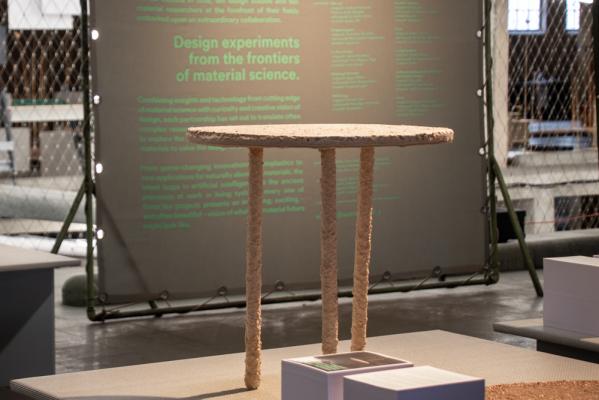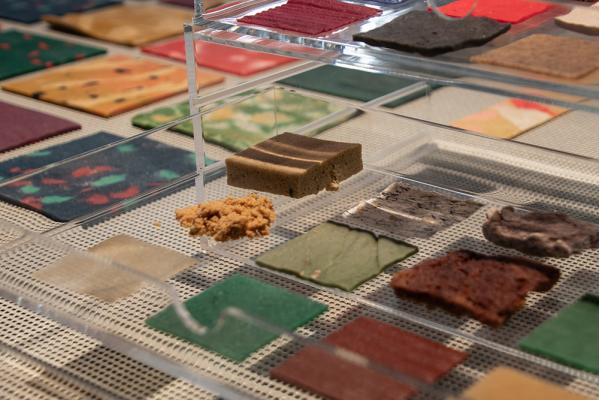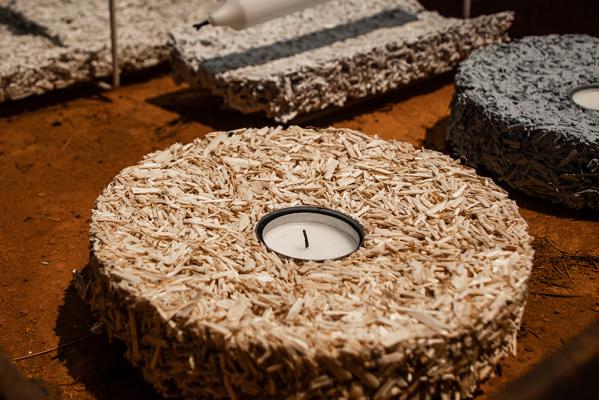We live in a world of depleting resources, of planet-damaging plastics and energy-hungry production processes. To survive, the design industry of tomorrow cannot rely on the materials of yesterday; there is a global need to find new ways of making, to develop new, sustainable materials and to find new applications for those that are naturally abundant but have been thus far neglected.
What Matter_s is a collaboration between Southern Sweden Creatives, Form/Design Center, SPOK, and Art & Science Initiative. Curated by designer and coordinator Nina Warnolf, the project aims to put the latest materials, insights and technology from the frontiers of science into the hands of designers keen to experiment with new materials, while giving scientists a rare opportunity to discover how their specialist knowledge might be realised in the design world. Because many manufacturers are often reluctant to risk taking on new experimental materials without a compelling commercial precedent, pioneering thinking often remains siloed in academic institutions for years. What Matter_s represents an attempt to unleash it.
‘We have been exploring and trying things that we don’t have opportunity to do in our everyday work and we can see interesting synergies when combining expertise from two completely different areas and creating something new. It’s a challenging and creative way of working.’
– Superlab
Each of the 10 designer/researcher pairs has been exploring a particular material for six months, with the researchers bringing their wide-reaching understanding of its chemistry, behaviours and properties, and the designers introducing curiosity, a fresh creative perspective and an eye for product opportunities into the mix. The materials range from the natural and ancient (such as chitin, hemp and spider silk) to the synthetic and hypermodern, (including bioplastics, nanowires and graphene), and even to the abstract and theoretical realm of algorithms.
Their task has been, not necessarily to create a new product or prototype (although many have done precisely this), but to find ways of translating often-complex research into meaningful, visually engaging forms; to tell the stories of their shared experimental process, and to demonstrate the potential that these new, untapped materials might have to solve the design challenges of tomorrow.
Follow the project instagram.com/whatmatter_s
LOCATION: Veem | Floor 2. Torenallee 80, Eindhoven.
ATTENDANCE AT STAND: 20–22 Oct: Petra Lilja, Studio Aikieu, Wang & Söderström. 21–24 Oct: Petter Thörne. 22–25 Oct: Superlab. 23–26 Oct: Jenny Nordberg. 25–28 Oct: Kajsa Willner. 26–28 Oct: Andreas Kojcevski Hansson & Siri Skillgate, Andréason & Leibel, Kunsik Choi.
The biggest design event in Northern Europe
Dutch Design Week (DDW) is the biggest design event in Northern Europe, presenting work and ideas of more than 2500 designers to more than 295,000 visitors from around the world. DDW is different from other design events, because it concentrates on the designs of the future. Although during the event every imaginable discipline and aspect of design is on offer, the emphasis is on experiment, innovation and cross-overs.
Southern Sweden Creatives is currently the biggest export-related project for the cultural and creative industries in Sweden. Form/Design Center is one of its nine partner organisations. The venture is part-funded by the European Union Regional Development Fund and the Swedish Agency for Economic and Regional Growth and runs from 2016 to 2019.
10 designers + 10 materials researchers
Silk Lab
– Andreas Kojcevski Hansson & Siri Skillgate + Dr Cedric Dicko
Most people think of silk as a fibre, one celebrated for its tremendous strength and elasticity; but designers Andreas Kojcevski Hansson and Siri Skillgate have taken a fresh perspective on the material. Drawing on the research and expertise of spider-silk expert Dr Cedric Dicko, who has ‘reverse engineered’ the fibre into its raw form of liquid silk protein – the same substance generated inside spiders and other silk-spinning insects – Silk Lab is the outcome of a playful series of cross-disciplinary experiments exploring different ways of (re-)solidifying silk. For What Matter_s, the team presents a series of 9 samples of silk in new and intriguing forms, alongside the tools they used to create them.
Both graduates in industrial design at Lund University, Andreas Kojcevski Hansson and Siri Skillgate first met during an internship in 2015, and recently decided to combine their skills in concept visualisation, communication and production innovation as the design duo KOSK.
Dr Cedric Dicko is a specialist in soft biomaterials at the Faculty of Engineering at Lund University. His research focuses on the production, properties and potential applications of protein-based materials such as spider silk.
Graphenogram
– Andréason & Leibel + Virgínia Boix
The carbon allotrope graphene is an astonishingly strong and versatile material but, at just a single atom thick, it is undetectable to the naked eye. One of the methods of making it is photo-thermal exfoliation, whereby a plate of acrylic glass coated in a solution of graphite oxide is exposed to high-intensity strobes of light, leaving a silvery layer of graphene on the surface. Observing that the image of anything obstructing that light becomes imprinted on the plate, Andréason & Leibel and Boix identified a parallel with Henry Fox Talbot’s invention of the photogram 200 years ago and began exploring the potential of graphene as a material component in a new photographic method. The result is the Graphenogram – a new kind of image created from the modern-day variant of a groundbreaking historic process.
Kristian Andréason and Kristin Leibel – aka Andréason & Leibel – run their studio in an old printing house in Arlöv, working on projects ranging from furniture and lighting commissions to experimental artistic works inspired by old masters.
Virgínia Boix is a PhD student in Lund University’s materials science programme, currently working on a thesis exploring 2D materials such as graphene and composites. She uses cutting-edge technology such as scanning tunnelling microscopy to visualise the results of her experiments at an atomic level.
In Vitro Printer
– Jenny Nordberg + Prof. Magnus Tägil
Inspired and influenced by bone healing in vivo (within the body), the In Vitro Printer is a 3D printer that recreates this process in vitro (outside it), building bone-like structures from the naturally occurring materials of collagen (in this case, a vegan alternative) and the calcium-based mineral hydroxyapatite, a variant of which constitutes much of human bone. As with natural bone healing, the printer uses no electricity or computer control; it is powered and operated by the human body alone. In a sense, the printer only exists in the presence of the body – it is an extension of the human machine.
Industrial designer Jenny Nordberg works at the threshold of art and design, using her practice to explore and expand contemporary notions of design, designer and their relationship to wider society.
Prof. Magnus Tägil works in the department of orthopaedics at Lund University. He is a research leader for its ‘Building Bone-Killing Bugs’ initiative and part of the Smart Bone project, both looking for materials that can be used as bone replacements in humans.
Polarised Portraits
– Kajsa Willner + Prof. Dmytro Orlov
Willner and Orlov’s exhibit is the result of a collaborative exploration of the properties of polarised light – an optical phenomenon that occurs when waves of light oscillate in a single plane. To create Polarised Portraits, linear polarisation filters are sandwiched around a transparent plastic that, when lit from behind, reveals stress patterns and birefringence (double refraction), creating colourful material portraits. The pieces on display – ‘Fallen Planet’ and ‘Strip’ – are made of a disposable fruit bag and protective packaging film, where the beauty of the effect makes a compelling contrast to the environmental consequences of plastic waste.
Kajsa Willner is a cross-disciplinary designer with an international background in furniture and industrial design. Her Malmö studio sets out to playfully challenge conceptions of what design is, creating products and interiors that introduce new ideas and concepts into everyday life.
Prof. Dmytro Orlov’s research focuses on understanding the properties of different metals and how that understanding might be used to develop new manufacturing techniques, such as in the design of light metals for use in biomedical and mobility applications.
MATching
– Kunsik Choi + Prof. Rajni Hatti-Kaul
As the environmental impact of conventional mass-produced plastics becomes ever more apparent and alarming, degradable, non-toxic bioplastics are becoming increasingly important as a potential alternative. MATching is the outcome of Kunsik Choi’s exploration of this rapidly developing field. Under the guidance of biotech specialist Prof. Hatti-Kaul, Choi has produced a series of handmade bioplastic plant pots that reference the tension between the natural, organic matter of the plant and the artificial, environmentally damaging properties of the material that conventionally holds it. Made by pouring pigmented liquid bioplastic into wooden moulds, the resultant vessels each have their own unique colour, shape and surface.
Kunsik Choi is a Korean-born independent designer based in Malmö, mainly working in furniture and product design. His aim is to create contemporary design with an emotional dimension that chimes with the specific needs of the user.
Prof. Rajni Hatti-Kaul works at the biotechnology department at Lund University, where she explores the properties and development of biomaterials and green chemicals.
Special thanks to project sponsor Perstorp.
Gleather Glubber
– Petra Lilja + Dr Ramune Kuktaite and Bill Newson
Gleather Glubber is the result of the meeting between the quantitative approach of scientific research and the explorative, artistic mindset of design. Over the course of six months, industrial designer Petra Lilja has drawn on the knowledge of bioscientist Ramune Kuktaite to develop recipes for bioplastic made from wheat-derived gluten. This installation showcases the various colours, textures and forms that can be created, and demonstrates the material’s versatility – it can be moulded into shapes like rubber, or cut and stitched, like leather. Through these swatches, and the accompanying example of a finished product (a biodegradable coffee-cup sleeve), Lilja presents a speculative exploration of the material’s potential for countless design applications.
Specialising in concept design, curation and exhibition design, Petra Lilja has dedicated her career to examining the role of the designer in a world where problems such as climate change, poverty and inequity can be traced back to design decisions.
Dr Ramune Kuktaite is an assistant professor at the Department of Plant Processing in Swedish University of Agricultural Sciences. Her research concerns the production of bio-based plastics and foams from plant materials such as potato starch and wheat proteins.
Grain
– Petter Thörne + Dr Paulien Strandberg
A by-product of the hemp industry, hemp hurds are the woody core of the hemp stem, usually burned for energy or used as animal bedding. As a bio-based material, it can also be used in combination with building limes for constructing sustainable walls. Because of their rough texture, hemp hurds rarely appears as an exposed surface. Tapping into the knowledge of building-material researcher Dr Paulien Strandberg, Petter Thörne has modified hemp hurds’ composition to support its use in interiors. By substituting the conventional binding agent, lime, Thörne has developed a variant that can easily be moulded into more refined shapes. This family of candleholders maintain and emphasise the rough-textured character of the material, using the candle flame to create a beautiful shadow play on the material’s surface.
Furniture designer Petter Thörne seeks to uncover the unexpected and poetic character of individual materials and material combinations. He is part of the multicultural makers collective Forma.
Dr Paulien Strandberg is a researcher in the department of building materials at Lund University, with special interests in the insulation and moisture-transport properties of bio-based building materials and the use of lime/hemp composites in construction.
Living Systems
– Studio Aikieu + Dr Solmaz Hajizadeh
Found in the shells of crustaceans, the exoskeletons of insects and the cell walls of fungi, chitin is the most widespread biopolymer in nature after cellulose. Chitin is highly versatile; it can be hard or soft, flexible or rigid, making it suitable for numerous industrial/biochemical applications. Interested in its possibilities as a design material, Jenny Lee of Studio Aikieu has worked with Dr Solmaz Hajizadeh to combine the repeatable methodology of a solution-orientated scientific approach with the curiosity-driven, experimental process of design. Taking inspiration from how living entities design and manufacture materials, Studio Aikieu has created chitin-based structural objects that indicate a potential route to a solution in an era of depleting resources.
Founded by designer and future-thinker Jenny Lee, Studio Aikieu operates at the intersection of design, science and technology, using speculative design to spark debate and discussion around the social, ethical and environmental implications of how we utilise science and technology to craft a better tomorrow.
Dr Solmaz Hajizadeh is a biotechnology and chemical engineering researcher at Lund University. Her work includes diverse projects related to nanotechnology, water/wastewater treatment and environmental engineering.
Artificial Intelligent Architecture and Interior Design
– Superlab + Dr Axel Nordin
Almost paradoxically, Suberlab’s project with Dr Axel Nordin uses artificial intelligence to foreground human needs and behaviours in the process of architectural design. Starting with data sourced from a large company, they have developed an algorithm to determine the optimal floor plan of an office in order to maximise positive psychology and encourage productive workplace behaviours such as collaboration. By allowing artificial intelligence to automate what would normally be a complex and time-consuming process for the architect, the system aims to improve both the efficiency and efficacy of the design process, as well as enshrining within it demonstrable human needs that are often sacrificed to meet economic requirements. A 3D-printed model of an AI-designed building demonstrates the Superlab algorithm in action.
Driven by research and innovation, Superlab is a Helsingborg-based experimental design company that collaborates with researchers, psychologists and experts in different areas to solve problems from new perspectives.
An assistant professor at Lund University, Dr Axel Nordin explores ways of integrating complex morphologies into bespoke products in order to address computational, manufacturing, structural and usability challenges. He is particularly interested in the application of artificial intelligence for engineering design.
Array
– Wang & Söderström + Prof. Magnus Borgström & Dr Vilgailė Dagytė
Array is a project intended to visualise and communicate the properties and geometry of one of the most remarkable structures in contemporary technology: the nanowire. Used in the creation of solar cells and other electronic devices, nanowires can be lab-grown as unique forest-like structures that enable them to absorb a large amount of energy, making them a highly efficient and cost-effective material for use in harvesting renewable energy. However they are are just a few hundreds of billionths of a metre in diameter, rendering them invisible to the human eye. To accommodate the impossibility of representing them at an accurate scale, Wang & Söderström have developed a prototype object that mimics the geometry of nanowires to regulate heat in a room. Array is designed to absorb excess heat and release it when the temperature cools, by incorporating a phase change material (PCM) that melts above 21ºC, absorbing thermal energy, and solidifies below it, releasing heat back into the room.
Comprising spatial/furniture designer Anny Wang and architect Tim Söderström, Wang & Söderström is an art and design practice with a focus on using digital/physical explorations and fabrication to create unexpected experiences through materiality and technology.
Prof. Magnus Borgström and Dr Vilgailė Dagytė work at NanoLund, researching the properties of nanowires, the techniques behind their manufacte, and how they might be used in renewable energy technologies such as solar cells.
The project has been carried out with support from the Swedish Visual Arts Fund's international programme, Iaspis. Special thanks to project sponsors Climator AB (Climsel PCM) and Tubbins Mekaniska AB.
Press images & films
Press kit with high resolution images, films and project texts are available here for downloading >>












